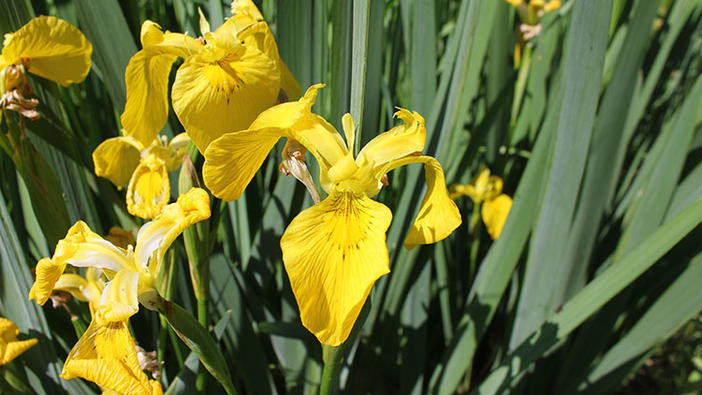Place of origin
Native to Africa, Asia and Europe, Pale yellow iris (Iris pseudacorus) was likely introduced to North America as an ornamental plant. Pale yellow iris has already been found in isolated locations in Alberta.
Habitat
Pale yellow iris grows in wetlands or along waterbodies. It can grow in water up to 25 cm deep.
Identification
Use keyboard or mouse to scroll through the gallery
- Pale yellow iris leaves are long, dark green and sword-like with raised mid-ribs that are slightly off-centre, overlapping in a fan-like arrangement starting from the base.
- Flowers are white to yellow with distinct purple to brown markings.
- Flat brown seeds form in large, green triangular capsules.
Reproduction
It is able to reproduce both by seed, easily dispersed by water, and through thick rhizome (root) fragments and bulbs.
Issues
- Pale yellow iris presents a human safety concern, as all parts of the plant are irritating to skin and poisonous to humans and animals if consumed.
- Infestations can displace native vegetation and alter water quality, reducing habitat for fish, wildlife and native plants.
- Dense rhizome mats in irrigation ditches, channels or storm water management ponds can increase sedimentation, disrupt the flow and availability of water and change wetlands to dry environments.
Current management in Alberta
Control of pale yellow iris can be difficult, especially once well established. Methods for control or eradication by trained personnel include:
- careful hand digging and benthic barriers for isolated or small populations
- repeated mechanical cutting and chemical treatment
Burning is not recommended, as regrowth is expected.
Care must be taken with hand digging and cutting to ensure all plant fragments are removed and disposed of. Fragments and seeds can drift with water movement and result in new infestations.
Resources
Help stop the spread of invasive plants
Report aquatic invasive species:
- Phone: 1-855-336-2628 (BOAT)
- Online: EDDMapS
Learn more about identifying and preventing invasive aquatic plants:
- List of prohibited species
- Aquatic Invasive Species Pocket Guide
- ALMS Field Guide to Aquatic Plants
- Invasive Plants (Alberta Invasive Species Council)
Spread the word about the threats invasive plants pose:





